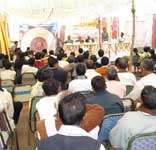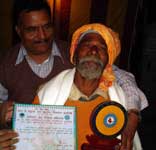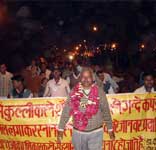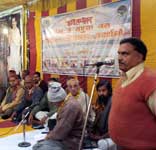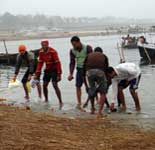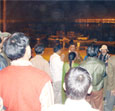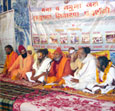- +91 9335 157 268
- shuklavn4@gmail.com
The Ganga is venerated in India as a mother, ‘Ganga Ma’ for her capacities to create, preserve and destroy life reflecting the same powers as those of the Hindu trinity of Brahma, Vishnu and Mahesh

“The Ganga, especially, is the river of India, beloved of her people, round which are intertwined her memories, her hopes and fears, her songs of triumph, her victories and her defeats. She has been a symbol of India's age-long culture and civilization, ever changing, ever flowing, and yet ever the same Ganga.”
Pt. JawaharLal Nehru
In a country, where practically everything in nature is venerated, the Ganga is most holy, considering the magnitude of her life sustaining forces it is no wonder. Ganga is an eternal river has been flowing in India as a lifeline.
Ganga is not just the name of a river; she has acquired the status of a Goddess and synonyms of all the rivers in which pure water is flowing. She has been considered as a cradle of great Indian Civilization, which has always paid emphasis on non-violence & co-existence. Infect the pure water of Ganga was responsible for the emergence and acceptance of such a pious thought's and vision which is now been recognized world over as an eco-culture and eco-ethics. "Ganga Jal" has become the synonyms of pure & pavitra. She is a faith, more than a river with which people of India are attached to; spiritually and emotionally for their psycho-religious and socio-cultural activities from times immemorial.
The Holy Origin of River Ganga
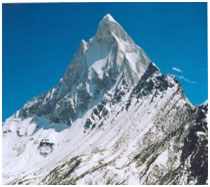 |
The mighty River emerges from the southern slopes of a Himalayan glacier named Gangotri glacier. Gangotri glacier is one of the largest glaciers in the Himalayas. The glacier is located in the Uttarkashi District of Uttaranchal State failing in the Garhwal Himalayan Region. This glacier is bound between 30°43'22"–30°55'49"(lat.)and 79°4'41"–79°16'34"(long.), extending in height from 4120 to 7000 m.a.s.l. The glacier originates at the northern slope of Chaukhamba range of peaks. |
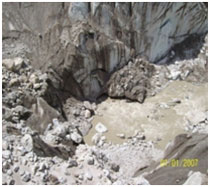 |
Bhagirathi, one of the tributaries of Ganga, originates from snout of Gangotri glacier, whereas Alaknanda, the other and main tributary emerges from the Bhagirathi Khark andSatopdnth glaciers, east of Chaukhamba peaks. Alaknanda meets Dhauliganga at Vishnuprayag, Nandakini at Nandprayag, Pindar at Karnaprayag, Mandakini at Rudraprayag and finally Bhagirathi at Devaprayag from here onwards, it is known as Ganga) in the Indian state of Uttarakhand. The rivers come under Ganga system. |
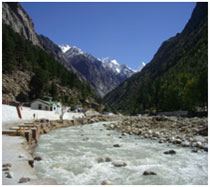 |
After flowing 250 kilometres (160 mi) through its narrow Himalayan valley, the Ganges emerges from the mountains at Rishikesh, then debouches onto the Gangetic Plain at the pilgrimage town of Haridwar. At Haridwar, a dam diverts some of its waters into the Ganges Canal, which irrigates the Doab region of Uttar Pradesh, whereas the river, whose course has been roughly southwest until this point, now begins to flow southeast through the plains of northern India. |
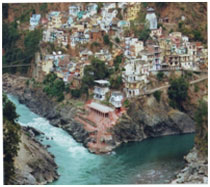 |
The Ganges follows an 800-kilometre (500 mi) arching course passing through the cities of Kannauj, Farukhabad, and Kanpur. Along the way it is joined by the Ramganga, which contributes an average annual flow of about 500 m3/s (18,000 cu ft/s). The Ganges joins the Yamuna at the Triveni Sangam at Allahabad, a holy confluence in Hinduism. At their confluence the Yamuna is larger than the Ganges, contributing about 2,950 m3/s (104,000 cu ft/s), or about 58.5% of the combined flow. |
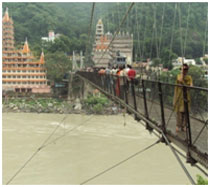 |
Now flowing east, the river meets the Tamsa River (also called Tons), which flows north from the Kaimur Range and contributes an average flow of about 190 m3/s (6,700 cu ft/s). After the Tamsa the Gomti River joins, flowing south from the Himalayas. The Gomti contributes an average annual flow of about 234 m3/s (8,300 cu ft/s). |
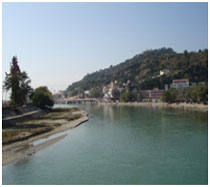 |
Then the Ghaghara River, also flowing south from the Himalayas, joins. The Ghaghara, with its average annual flow of about 2,990 m3/s (106,000 cu ft/s), is the largest tributary of the Ganges. After the Ghaghara confluence the Ganges is joined from the south by the Son River, contributing about 1,000 m3/s (35,000 cu ft/s). |
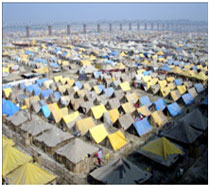 |
The Gandaki River, then the Kosi River, join from the north, contributing about 1,654 m3/s (58,400 cu ft/s) and 2,166 m3/s (76,500 cu ft/s), respectively. The Kosi is the thirdlargest tributary of the Ganges, after the Ghaghara and Yamuna. |
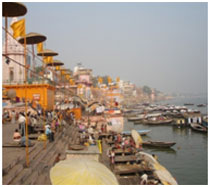 |
Along the way between Allahabad and Malda, West Bengal, the Ganges passes the towns of Chunar, Mirzapur, Varanasi, Ghazipur, Patna, Bhagalpur, Ballia, Buxar, Simaria, Sultanganj, and Saidpur. At Bhagalpur, the river begins to flow south-southeast and at Pakur, it begins its attrition with the branching away of its first distributary, the Bhāgirathi-Hooghly, which goes on to become the Hooghly River. |
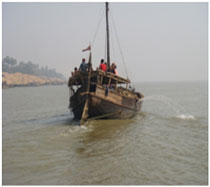 |
Just before the border with Bangladesh the Farakka Barrage controls the flow of the Ganges, diverting some of the water into a feeder canal linked to the Hooghly for the purpose of keeping it relatively silt-free. |
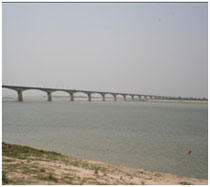 |
The Hooghly River is formed by the confluence of the Bhagirathi River and Jalangi River at Nabadwip, and Hooghly has a number of tributaries of its own. The largest is the Damodar River, which is 541 km (336 mi) long, with a drainage basin of 25,820 km2 (9,970 sq mi). |
The Hooghly River empties into the Bay of Bengal near Sagar Island. Between Malda and the Bay of Bengal, the Hooghly river passes the towns and cities of Murshidabad, Nabadwip, Kolkata and Howrah. Place wher Ganga meet with Ocean is called GangaSagar After entering Bangladesh, the main branch of the Ganges is known as the Padma. The Padma is joined by the Jamuna River, the largest distributary of the Brahmaputra. Further downstream, the Padma joins the Meghna River, the second largest distributary of the Brahmaputra, and takes on the Meghna's name as it enters the Meghna Estuary, which empties into the Bay of Bengal.
The Ganges Delta, formed mainly by the large, sediment-laden flows of the Ganges and Brahmaputra rivers, is the world's largest delta, at about 59,000 km2 (23,000 sq mi). It stretches 322 km (200 mi) along the Bay of Bengal.
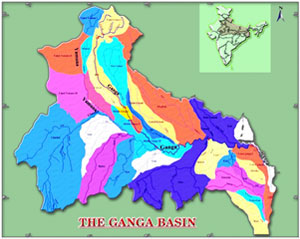
- Total length of about 2525 Km. in the northern part of the Indian subcontinent
- It had the largest grass sown area of nearly 50 million hectares and caters for nearly 37% of lndia's total population.
- The basin has a population of 560 million (apporx.).
- The Ganga Basin is incredibly fertile and, at present, about one in every 12 people in the world (8%) lives in its catchment area.
- The Ganga is the 15th largest river of Asia and the 39th largest in the world.
- The Ganga River flows in a basin inhabited by 560 million people, making it the most populous river basin in the world. This basin measures about one million square kilometres and has a mean annual flow of over 400,000 million cubic kilometres. It includes part of the territories of India, Nepal, Bangladesh, and China (Tibet).
- Within India, it includes the states of Haryana, Uttranchal, Uttar Pradesh, Bihar, Jharkhand West Bengal, Rajasthan, Madhya Pradesh, Himachel Pradesh, and Delhi, and covers more than one quarter of India’s total area.
- The basin has nearly 700 towns and cities of which 29 have a population greater than 100,000 people do and 23 have population between 50,000 and 100,000 people containing approximately 37% of the country’s population or nearly 560 million people.
Eighteen major canal structures on the Ganga river system irrigate about 7 million hectares of agricultural land
Holy River Ganga: At A Glance |
|
Countries |
India & Bangladesh |
Origin |
‘Gomukh’ Gangotri glacier Uttarkashi District of Uttaranchal State failing in the Garhwal Himalayan Region |
Coordinates |
East Longitudes- 730 30’ and 890 0’ |
Elevation |
7,756 m (25,446 ft) |
Main Stream |
‘Bhagirathi’ emerging from Gomukh (At Deoprayag, Bhagirathi river meets with Alaknand River coming from near Badrinath Tample Santopath Glacier, onward stream is known as ‘Ganga’) |
Length |
2,525 km (1,560 miles)- including five states |
Mouth |
Ganga Delta, Bay of Bengal |
Tributaties |
210 Large & medium sized rivers (main tributaries are Yamuna, Ram Ganga, Gomati, Saryu, Ghaghara, Gandak, Sone, Kosi, Mahananda, Haldi, Ajay, Mayurkoshi, Damodar) |
Ganga Basin Area |
10, 86,000 sq.km in India & Bangladesh |
Population |
448.3 million as per 2001 Census of India (43% of population) |
Population Density |
575 km2 |
Water Discharge |
18.7x105 |
Watershed Area |
9,07,000 Km2 |
Annual Flow |
525 billion cubic meters (25.2 % of India’s total water resources) |
Hydel Potential |
11,579 MW |
Total cultivable area |
21,109 km2 |
Cultivable net area |
0.6x106 hectare |
Irrigational potential |
27,350 thousand hectare |
Irrigated agricultural land |
7 million hectare |
Sediment Load |
2.4 billion metric tons per year |
Waste/municipal water discharge |
2683.6 million litre per day |
Industrial effluent discharge |
285.9 million litre per day |

Myth behind the Ganga
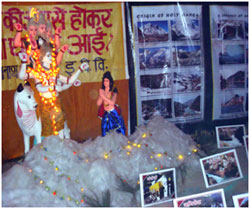 Myths suggest that the sacred river is an integral feature of the spiritual-mental-physical ecosystem of the universe, and its descent through the three worlds of heaven, earth, and the underworld is perhaps given fullest expression in the mythology of the Ganga.
Myths suggest that the sacred river is an integral feature of the spiritual-mental-physical ecosystem of the universe, and its descent through the three worlds of heaven, earth, and the underworld is perhaps given fullest expression in the mythology of the Ganga.
Moved by the penance of the royal sage Bhagiratha, a descendant of King Sagara Ganga agreed to descend to earth to purify the ashes of Sagara's 60,000 sons. Ganga then swept down in three great torrents which would have flooded the earth had not Siva caught the waters upon his brow and broken their fall. Being again propitiated by Blagiratha, Ganga followed him to the sea and thence to the nether regions to fulfill her mission, purifying Sagara's sons and thus enabling them to attain paradise.
GANGA AS A GODDESS (ICONOGRAPHY)
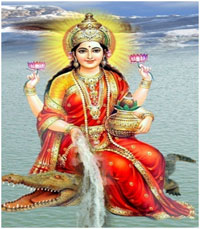 In the cannons of Indian art, Ganga is visualized, as all other major Indian goddesses are, voluptuous and beautiful. A woman is like this vessel, carrying in her the vital and throbbing life essence. The overflowing pot is the grace of nature in abundance and this is a symbol of the sustaining womb, holding within itself the force of life. In Indian aesthetics, wherever the pot appears, it conveys the idea of abundant life and fertility, which nourishes and sustains the universe. Ma Ganga sitting on Crocodile (Makar).The crocodile is a unique animal in that it can live on both land and sea. It thus denotes the wisdom of both the earth and waters.
In the cannons of Indian art, Ganga is visualized, as all other major Indian goddesses are, voluptuous and beautiful. A woman is like this vessel, carrying in her the vital and throbbing life essence. The overflowing pot is the grace of nature in abundance and this is a symbol of the sustaining womb, holding within itself the force of life. In Indian aesthetics, wherever the pot appears, it conveys the idea of abundant life and fertility, which nourishes and sustains the universe. Ma Ganga sitting on Crocodile (Makar).The crocodile is a unique animal in that it can live on both land and sea. It thus denotes the wisdom of both the earth and waters.
Religious Significance
- The holy water of the river plays a vital role in Hindu ceremonies, in rituals of birth and initiation of marriage and death.
- It is believed that any water that mixes with even the smallest amount of Ganga water becomes holy with healing powers
- Hindus also believe life is incomplete without bathing in the Ganga at least once in their lifetime.
- In most Hindu families, a vial of water from the Ganga is kept in every house. This is done because it is auspicious to have water of the Holy Ganga in the house.
- The gravest of sins like Brahmhatya (killing of a Brahmain) and Gauhatya (killing of a cow) gets absolved by the mere touch of Ganga holy water.
The rivers of earth are therefore seen as being necessary to creation and as having a heavenly origin. On its bank, from the very beginning of time many of Rishis, Munis and Tapasvis have been performing their spiritual endeavours.
The holy sight of Ganga gives knowledge, splendours, name, fame etc. The gravest of sins like Brahmhatya (killing of a Brahmain) and Gauhatya (killing of a cow) gets absolved by the mere touch of Ganga holy water. Himself has described the Importance of river Ganga in the following way, he says to
Uniqueness of Ganga Jal
Ganga has nourished our glorious culture in the past time, saved us from deadly disease through her mysterious phermacutical properties.
(जब शरीरं व्माधियों व रोगों के कारण दुर्बल हो जाता है तो नारायण हरि रूपी वैध के चरणों से निकली गंगा का पवित्र जल औषधि रूप में लाभ दायक सिद्ध होता है।
(When the body is afflicted by senility and diseases the Holi water of mother Ganga is the medicinc, and lord Narayan (Hari) from whose feet Ganga enanated, is the great Physician.
The unique qualities of the Ganga water are well described in Ayurveds. It remov¬es unconsciousness; thirst, burning sensation of body, fatigue, stomach disorder and in-creased longevity
Chakrapanidutta in 1060 A.D. regarded Ganga water as sole de¬stroyer of all diseases.

SCIENTIFIC APPROVAL
To this date the water of holy Ganga is believed to have Amrit (nectar) in it. It has been studied by Scientists that the water collected from Ganga at its origin is in a pure state and even after being kept for several years, does not get contaminated.
- Sri Ganga Nath Sen even describes the curative powers of Ganga soil for treatment of Skin diseases and blood impurities.
- Mark Twain noted that the Ganga had the capacity of self purification.
- C.E. Nelson observed that Ganga water is antiputrefacation nature:
Normally river water begins to putrefy over a period of time due to lack of oxygen which promotes the growth of anaerobic bacteria, which in turn gives rise to the smell of stale water
- E. Hanbury Hakin reported that Ganga water is antibacterial nature:
The bacterium Vibrio Cholerae which causes the deadly Cholera disease, when put into the waters of Ganga died within three hours! The same bacteria continued to thrive in distilled water even after 48 hours!”
- Felix d’Herelle “only a few feet below the bodies of persons floating in the Ganga who had died of dysentery and cholera, where one would expect millions of germs, there were no germs at all”!
- D.S. Bhargava, measured the Ganga remarkable self cleansing properties
- The Ganga, show that it is able to reduce BOD levels much faster than in other rivers.”
- The Ganga seems to clean up sus¬pended wastes 15 to 20 times faster than others rivers
- The Ganga has an extraordinarily high rate of reaeration, the process by which it absorbs atmospheric oxygen. DO much longer than does water from other rivers
- The presence of heavy materials like silver, copper, iron, chromium and nickel; and, the presence of minute quantities of radio-active materials such as Bismuth.
- The medicinal properties of Ganga-Jal are attributed to the medicinal secretions of herbs and mineral content which get mixed with the water.
- The country's Mughal rulers, from Muhammad-bin-Tughlak to Akbar and Jahangir to Aurangzeb, kept Ganga water in their kitchens at Delhi and Agra for its medicinal properties.
No river in the world plays a more important economic, social and cultural role in the lives of more people than the Ganga. Emerging from the central Himalayas, the river flows through the north Indian planes, providing water and drainage for over 560 million people. It is a meeting point for both the rich and poor, who believe it is a divine route to heaven. Ironically, this divine status may be threatening the river's very existence.
BACTERIOPHAGE : THE ESSENCE OF GANGA JAL
Ganga water never get polluted even when stored. It also has a microorganism known as ‘Bacteriophage’, which has the special property of killing of the bacteria present in water.
Bacteriophase require a specific host to complete its reproduction cycle. The Bacteriophase present in Ganga water is unique in the scenes that it can insert its genome in almost all type of Bacteria (Host) and can bring about lysis but it completes is reproductive cycle only in a specific bacterial cell (E. coli). These properties of Bacteriophase of Ganga water is not known in other types of Bacteriophases, thus no harmful bacteria can multiply or exist in the Ganga water. So Ganga water considered as “Amrit”.
GANGA, THE SOURCE OF INSPIRATION
“The land where the Ganga does not flow is likened in a hymn to the sky without the sun, a home without a lamp, a Brahmin without the Vedas.”
In Hindu mythology all the things that support life are considered as a form of Shakti and thus termed as a god/goddess to worship. Almost all cultureas developed in river banks and this itself. Besides that, we must know that the Hindu civilisation is a completely logical civilisation. Logically, by worshipping rivers, we learn to respect and preserve them, as we do to other natural features.

